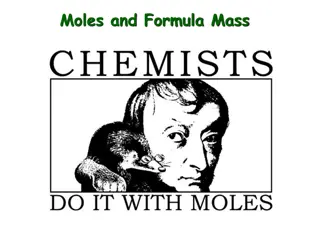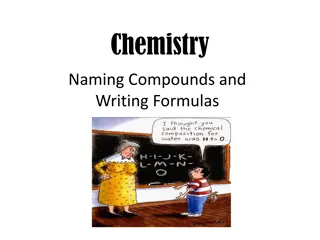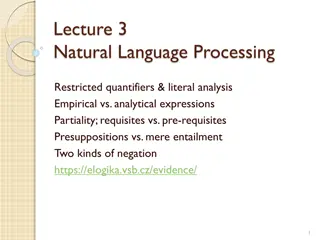Understanding Percent Composition and Empirical Formulas in Chemistry
The Law of Definite Proportions governs the composition of compounds based on molar masses, allowing us to calculate percentage compositions of elements within a compound. Through examples involving various compounds like Fe3C, sulfur dioxide, ammonium nitrate, glucose, and acetic acid, we explore the process of determining percent compositions and deriving empirical formulas.
Download Presentation

Please find below an Image/Link to download the presentation.
The content on the website is provided AS IS for your information and personal use only. It may not be sold, licensed, or shared on other websites without obtaining consent from the author. Download presentation by click this link. If you encounter any issues during the download, it is possible that the publisher has removed the file from their server.
E N D
Presentation Transcript
The Law of Definite Proportions states that a compound is always comprised of the same atoms in the same ratio, or percentage. In order to determine the percentages, we use molar mass
Percent composition gives you the ratio of the mass of one element to all the other elements that make up a unique compound. Methane, CH4, is comprised of 1 atom of carbon and 4 atoms of hydrogen. The molar mass of methane is 16.04 g/mol Carbon contributes a total mass of 12.01 g/mol All Hydrogen atoms together contribute 4.03 g/mol The ratio of C:CH4is 12.01:16.04 or 74.88% The ratio of H:CH4is 4.03:16.04 or 25.12% So therefore, the percent composition of methane is 74.88% Carbon and 25.12% Hydrogen
1. Calculate the % composition of Fe3C, a compound used to cast iron. 2. Calculate the % composition of sulfur dioxide. 3. Calculate the % composition of ammonium nitrate. 4. Calculate the percent composition of glucose, C6H12O6. 5. Calculate the percent composition of acetic acid, CH3COOH.
1. Calculate the % composition of Fe3C, a compound used to cast iron. Fe = 55.85 g/mol x 3 = 167.6 g/mol C = 12.01 g/mol Fe3C = 167.6 g/mol + 12.01 g/mol = 179.6 g/mol % Fe = 167.6 g/mol / 179.6 g/mol x 100 = 93.32% % C = 12.01 g/mol / 179.6 g/mol x 100 = 6.69%
1. 93.32% Fe, 6.69% C 2. 50.05% S, 49.95% O 3. 35.00% N, 5.05% H, 59.96% O (p.s. the formula is NH4NO3) 4. 39.99% C, 6.73% H, 53.28% O 5. 39.99% C, 6.73% H, 53.28% O !!!! What is the empirical formula for each?!!!























